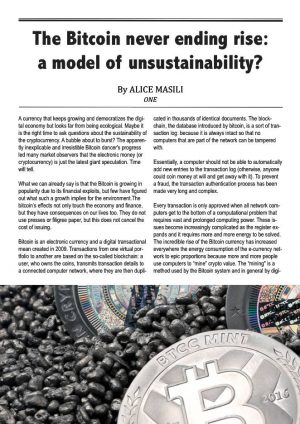 A currency that keeps growing and democratizes the digital economy but looks far from being ecological. Maybe it is the right time to ask questions about the sustainability of the cryptocurrency. A bubble about to burst? The apparently inexplicable and irresistible Bitcoin dancer’s progress led many market observers that the electronic money (or cryptocurrency) is just the latest giant speculation. Time will tell.
A currency that keeps growing and democratizes the digital economy but looks far from being ecological. Maybe it is the right time to ask questions about the sustainability of the cryptocurrency. A bubble about to burst? The apparently inexplicable and irresistible Bitcoin dancer’s progress led many market observers that the electronic money (or cryptocurrency) is just the latest giant speculation. Time will tell.
What we can already say is that the Bitcoin is growing in popularity due to its financial exploits, but few have figured out what such a growth implies for the environment.The bitcoin’s effects not only touch the economy and finance, but they have consequences on our lives too. They do not use presses or filigree paper, but this does not cancel the cost of issuing.
Bitcoin is an electronic currency and a digital transactional mean created in 2009. Transactions from one virtual portfolio to another are based on the so-called blockchain: a user, who owns the coins, transmits transaction details to a connected computer network, where they are then duplicated in thousands of identical documents. The blockchain, the database introduced by bitcoin, is a sort of transaction log: because it is always intact so that no computers that are part of the network can be tampered with.
Essentially, a computer should not be able to automatically add new entries to the transaction log (otherwise, anyone could coin money at will and get away with it). To prevent a fraud, the transaction authentication process has been made very long and complex.
Every transaction is only approved when all network computers get to the bottom of a computational problem that requires vast and prolonged computing power. These issues become increasingly complicated as the register expands and it requires more and more energy to be solved.
The incredible rise of the Bitcoin currency has increased everywhere the energy consumption of the e-currency network to epic proportions because more and more people use computers to “mine” crypto value. The “mining” is a method used by the Bitcoin system and in general by digital currency to issue money. The system does not print money; it discovers money. The miners make available their computers’ computing power to perform these calculations. In return for each successful check, they receive free BitCoins.
As estimated by the analyst Alex de Vries on Digiconomist through the Bitcoin Energy Consumption Index, Bitcoin miners will use more than 24 terawatt-hours (TWh) of electricity per year. This number gives an idea of how nature plans to carry on with the Bitcoin: that amount of energy corresponds to the annual consumption of the whole of Nigeria, a country of 186 million inhabitants.
In a report published by the International Energy Agency, De Vries sustains that the entire Bitcoin network now consumes more energy than countries like Oman and the Netherlands. A recent research on the energy consumption of the bitcoin network, carried out by the Hamilton Institute and the University of Maynooth in Ireland, points out that the energy used by Bitcoin mining is “comparable to Irish energy consumption.”
The need for energy consumption corresponds to a more prominent demand and a more considerable resource utilisation: this is the real environmental impact of the digital money.The American magazine Motherboard calculated that each Bitcoin transaction consumes about 215 kilowatts per hour. An average US household consumes approximately 900 kilowatts per month, if we multiply that figure for the 300,000 daily transactions occurring all over the world, it is easy to get dizzying numbers. It is clear that Bitcoin miners could use enough electricity to maintain about 2.26 million US homes. These figures make us realize that Bitcoins have a high environmental impact due to their extreme high-energy consumption. They would even contradict the objectives of the Paris Agreement. In today’s world, where the attention to energy consumption and climate change is becoming an integral part of everyday life, is there any need for such a power-consuming currency?
It is not the first time we have to face with an energy crisis, and certainly, it will not be the last. However, the mining community is working to fix the problem, proposing cheaper and more eco-friendly alternatives for generating electricity to power their miners and to make the monetary withdrawal more sustainable from an energy point of view.
Several ideas have recently been proposed to improve the sustainability of crypto-money. A Russian startup, Comino, offers, for example, radiators able to transform this heat into useful heat.
Another idea is OgNasty, a Bitcoin mining company, which launched in 2012 the Green Energy Bitcoin Mining Project, which uses renewable energy (mainly solar and wind power) to extract currency. An Australian company, HydroMiner, uses hydropower to operate its mining farms, lowering the electricity cost of 85 percent compared to the European average. Genesis Mining, arguably the largest Bitcoin mining company in the world, uses the green electricity generated in the country’s geothermal power plants to power its mining farms in Iceland.
It may not be enough. It might be time to rethink the architecture of the digital currency. A more energy-efficient, cheaper and greener extraction method will keep the bubble intact. And its surroundings too.
Alice Masili

